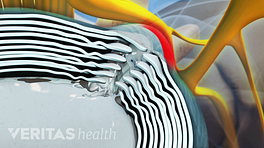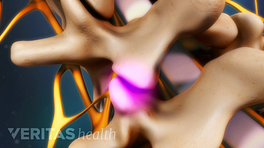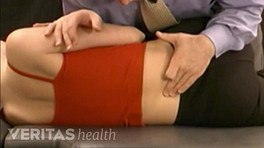A spinal disc consists of two main parts: the jelly-like nucleus pulposus in the disc's center and the outer-most layers, collectively called the annulus fibrosus. These two components facilitate the spine's movement and provide support for the vertebrae.
Disc degeneration or trauma can cause the nucleus to herniate through the weakened layers of the outer disc and leak out of the annulus fibrosus into the spinal canal.
In the case of a lumbar herniated disc, the weak spot in the annulus fibrosus is directly underneath the spinal nerve root, so a herniation in this area can put direct pressure on the nerve.
The nerve root extends down the leg, and any type of pinching or pressure on the nerve in the lower spine can cause pain, numbness, tingling, or weakness to radiate along the path of the nerve down the leg. However, many people have shown a herniated disc on MRI scans yet have no associated pain, so not all herniated discs will cause symptoms.










